By: Travis Allen
The introduction of fake cards into the market bears poorly for Magic as a whole. Intended to be a cheap alternative to authentic cards, they’re created with the express purpose of allowing players to get their hands on cards they couldn’t (or wouldn’t) otherwise afford. Frequently the quality has been poor, especially so in the past, but they’re getting much better. Their existence undermines the premise of Magic as a collectible card game by devaluing authentic copies. We need to be aware that these exist, and that they contribute to making the game more unstable as a whole.
You guys are thinking of proxies too, right?
Proxy Wars
For those unfamiliar, proxies are fake cards that make no effort to disguise their identity. As homemade cards, there’s no restriction on not only what art is used, but every visual aspect. Borders are extended or removed, power and toughness boxes shift, set symbols may disappear or change, and the art ranges from renaissance paintings, to high-quality digital pieces, to manchild ponies, to topics too vile to mention here.
Proxies are almost exclusively used in noncompetitive environments. Cubes tend to be the most common home of proxies, for two reasons. The first is that cubes are often considered a vehicle for personal expression, a reflection of the individual that owns it. Personalization of cubes can manifest in more than one manner. Draft archetypes can be aligned with the owner’s personal preference, such as whether to make the black and white combination aggro, enchantments-matter, spirits, or to not even include an archetype for that pair. Aesthetics are no different. Cube owners already spend time debating which version of Demonic Tutor they prefer—Beta, Divine vs Demonic, or the judge foil—so the option of adding completely custom card faces is a natural extension.
The second, more obvious reason that cubes frequently take advantage of proxies is that cubes tend to include expensive cards. While not all cubes include the power nine, many do, and we’re all well aware of how expensive even played Unlimited power is. For a cube owner seeking to have beautiful cards in each sleeve, the idea of shelling out for SP Alpha or Beta copies is unpleasant to say the least. With proxies offering substitutions for Moxes at 1/100th the cost, along with the additional option of customizing the appearance with unique or personal art, it’s no surprise that this is a common path.
Proxies are popular in EDH as well, another singleton format with many of the same characteristics as Cube. While the default method of upgrading an EDH deck is to foil it out, many choose to take other routes, including custom alters or proxies for most or all of the cards in a deck. While power is banned, there is still no shortage of expensive cards to use in EDH, and as such proxies often appear in this format as well. When choosing between an authentic $180 Gaea’s Cradle and a $10 Gaea’s Cradle proxy for use in a strictly casual deck, the choice for a cash-strapped player is often simple.
Cradle to Ghave
If we consider what “proxy” actually means, it may help to illuminate the gap between their use and their intent. In natural, non-Magic English, a proxy is something that stands in for something else. Pinch hitters in baseball are proxies. A proxy server stands in between you and the website you’re attempting to reach, acting as the true content while sidestepping network security (which is especially useful when a content site like SCG is blocked at work but the proxy website isn’t). In Magic, when your draft deck is 39 $.10 cards and a single foil Jace, Vryn’s Prodigy, you don’t want to bother sleeving up. You sharpie “Jace” onto a basic Mountain, and voila: that card is a proxy. You get the idea. A proxy is meant to stand in for the real thing.
Consider again that proxy Gaea’s Cradle in an EDH deck. What is that standing in for? For a real copy of Gaea’s Cradle, right? But which real copy?
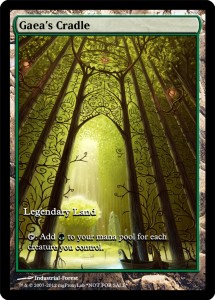
When you pull a foil mythic in a draft and don’t want to bother sleeving up the deck just for a single card, you shove a proxy into your deck and keep the foil in your deck box. The proxy card refers to something quite real: that card, right there, in your deck box. You can lift that card up and hold it and put it on the table after you’ve cast the sharpied Forest in your hand. The proxy is a substitute for an immediately available card.
How about that proxy Cradle in the EDH deck though? If you don’t own a true Gaea’s Cradle, what is it proxying? It’s not proxying your judge copy that you’ve got set aside so that you don’t have to shuffle it. It’s not a substitute for any card in your home. No, it’s proxying some other copy. A copy that belongs to someone else. Your proxy Cradle is there, representing the real Gaea’s Cradle still in your LGS’s glass case, the one you didn’t purchase. It’s proxying the real Cradle still in that person’s binder that you didn’t bother to trade for because it was too expensive. It’s proxying any real copy of Cradle—none of which you own.
People don’t feel bad buying a proxy Cradle because it looks nothing like the real thing. How close can it get? How similar can the proxy and the real card be before you’re uncomfortable with it? If I start selling fake cards that are identical to the real thing and I market them as proxies, am I really selling a proxy, or am I selling a counterfeit?
Fiat Currency
Counterfeits are fake cards. People buy them so they don’t have to own the real cards. Real cards are expensive, and counterfeits are cheap, and they get the job done just as well. If it looks like a duck, and taps like a duck, and costs a small fraction of a duck, why not buy the counterfeit duck? (This has been answered before, so I’ll refrain from explaining why counterfeits are bad for Magic today.) Sounds a lot like a proxy, right?
Counterfeit cards are not created or endorsed by Wizards of the Coast. They are not official cards. They exist so that people can buy them instead of real cards. When you buy counterfeit cards, you’re undermining the market for Magic cards. Instead of investing in genuine product, you’re giving it to people who are actively devaluing authentic product. All of this is true of proxies as well.
Clearly there is a difference, and I’m not blind to it. Counterfeits are designed with the express purpose of tricking people. They’re intended to deceive players and judges in competitive environments. Even if the counterfeit websites don’t say “fleece some idiots” on them, and instead recommend them only for kitchen table play, that’s obviously a weak deflection of responsibility. There’s deliberate malicious intent in the creation of counterfeit cards, just as there is with counterfeit handbags and shoes and watches and everything else.
I don’t believe that there is much or any malicious intent in the creation of proxies. No one is trying to deceive others into believing these cards are real. In fact, it’s just the opposite: proxies are remarkably and expressly different from real cards so that there is no chance of confusion (or lawsuits). Proxies are all about exploring different art styles and layouts that Wizards can’t, adding custom imagery to your game, and spicing up your decks. And as per @theproxyguy, they’re about “making Vintage, Cube, and EDH accessible since 2010.”
While counterfeits are intended to deceive and proxies are not, the two are opposite faces of the same coin. Both are fake cards that players can use instead of real cards. Fake cards that cost way, way less than real cards do. On one hand, it’s a predatory business model that seeks to steal profit from Wizards. On the other, it’s a bunch of folks looking to add flavor to their cubes and skip spending thousands of dollars on power. Intent is a dividing line here, and while counterfeits are ill-intentioned and proxies are well-intentioned, you know what they say. The road to hell is paved with good intentions.
All Things Considered
I’m not blasting people that make proxies or use proxies. That is not my goal. Hell, I’ve done it myself. In what was theft twice over, I found myself lacking a Reaper King for my Reaper King EDH deck. Shamelessly lifting the idea from elsewhere, I printed out a QR code that linked to Reaper King’s magiccards.info page and shoved that into a sleeve instead.
My goal in bringing this to everyone’s attention isn’t to ruin the party, but to make it abundantly clear that while you may love the images and artwork of proxies, they are not an entirely innocent practice. No, you’re not looking to scam people with them, but you are indirectly taking money out of WOTC’s pocket, just as counterfeits do. It’s not as extreme or deliberate, but the end result is still similar, if certainly less pronounced. If you scoff at this, imagine someone proxying an entire EDH deck. Would you be thrilled about playing against that when you had saved to buy all the real copies yourself? How about if she’s proxying a Gaea’s Cradle, a card currently missing from your deck because you haven’t yet been able to purchase it? Do you think perhaps it’s going to burn you just a little when she’s tapping her fake Cradle while you lack one yourself?
Now how about an entire local community that proxies their EDH decks? That LGS owner is going to have a lot of unsold Sol Rings in his case that he wouldn’t have if everyone hadn’t used proxies.
Proxies occasionally look phenomenal, and the well done ones are certainly striking. A well-curated cube of all proxies can be packed with flavor and personality that makes it uniquely yours. Just remember when you’re considering them as an option, a proxy is only a proxy if it’s standing in for a card you own. If you don’t have the card you’re proxying, it’s not a proxy anymore. It’s a counterfeit.
[/hide]


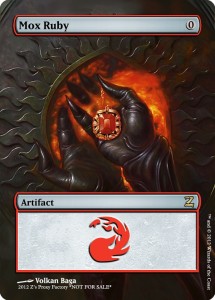

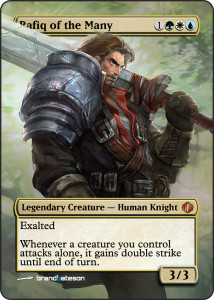
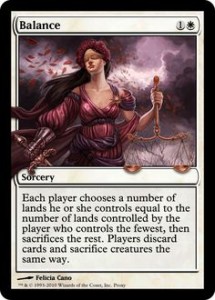
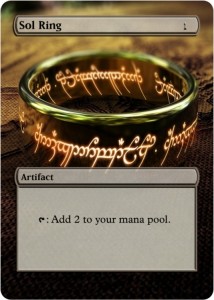
Excellent article. Could you perhaps make this free to read? I suspect the topic would be useful for a wider audience.
I feel like this is the type of topic that should be available for free.
I agree completely that this should be a free article. This can be a problem especially for EDH players who want to pimp out their decks but not actually purchase the cards. As was mentioned, there is a huge difference between proxies that stand in for cards you own versus filling a financial hole.
Granted, I have a foil Mox Opal and Black Lotus proxy, but I mainly just use them for bookmarks anyways…. ;P
I should start out by saying that I thoroughly enjoyed the article and I agree with many points you made, such as how playing against copies in a casual setting can be a feel-bad, and how there is a fine line between proxies and counterfeits on an ethical level. I recently had a few experiences with proxies that give me a somewhat different perspective on them and I wanted to share my opinion.
I think proxying cards is a great idea in cube so that you can happily draft with people you don’t implicitly trust. I recently put together a cube and it is a challenge finding a group of 8 people I can trust to not steal cards to get a draft in. If I were to proxy the more expensive cards, I’d feel much better about drafting with strangers. Coming to this realization makes me question why I bought those cards to begin with if I’m by default not going to use them.
I totally understand the difficulty with ‘proxies’ in decks for events. My LGS hosts Modern (unsanctioned) with proxies allowed, and it’s difficult to play the budget deck that I built with cards I could comfortably afford vs. an inkjet printed Junk Midrange deck. If I truly saw that as a problem though, I could go play in an actual sanctioned event and not have to deal with it.
If an LGS is feeling like proxies are causing sales decreases, it may be worth hosting sanctioned events where proxies aren’t allowed, or maybe make the buy-in steeper for decks using some number of proxies. This can encourage those EDH players to buy their Sol Rings to swap into for the event. I’m certain that there are also times that a player proxies a deck to try it out, loves it, and then seeks to purchase it for competitive use, so I’m sure it’s not a purely detrimental practice. That said, I’m not an LGS owner, so I could easily be entirely wrong about this.
Even if you believe that play against a deck with a bunch of proxies is a bad experience, I would argue that in many cases the opposite can be true with a cube. With unfortunate hindsight, I now think one should start with proxies, maybe even just cards with a name written on in marker so that your playgroup can determine if it’s actually fun to include before you buy that Library of Alexandria. The worst feeling is buying an expensive card, and playing with it, only to determine that everyone, including yourself, believes it’s not a good fit.
Why is this not a free article?
If this was a serious problem at sanctioned events or if magic was suffering a crises because too many people were just buying proxies and there wasn’t a market for real cards, I would be much more against proxies. The fact that: sanctioned events do not allow proxies, you can enforce a casual ban on proxies and that the collectible aspect of mtg is still held in high regard, makes me not too concerned about clearly distinguished proxies. Proxies are only a threat if people lie about their authenticity or if Wotc fails to keep up with reprints.
See I agree totally. I mean seriously what are the most proxied cards? The high dollor cards. I myself proxy entire decks. It allows me to test play and tweak in or out useful and unuseful cards. I can’t justify spending $50 on a card that does a deck no good. In my experience proxies lead to purchase of legit versions. They allow players to test play cards that yeah they can afford but do not want to pump money into cards that do them no good in real play. As for a seller having a stack of sol rings for sale due to proxies rotflmfao. I buy and sell quite a bit on ebay and never had an issue with selling any card. If sellers can’t unload their stock its because they over price their cards and don’t keep up with trending prices or because they go in deep on a sketchy card and try to make up the difference by jacking up prices on other cards. As for the power nine duh no brainer common players can not afford to shell out 3000-100000 for a card to put in their deck. The people who play power nine proxies play proxies for a reason. 1 wizards no reprint policy of the power nine. 2 their not millionairs and 3 if they were milionairs and bit my toungue saying this but they would have far better things to do than play magic.
Here is a perfect example of why proxies exist. Every single brick an mortor shop I can find sells from the vault angels for no less than $70. A $35 set that hasn’t even made it to public release yet is listed at no less than $70. This is why proxies exist. Because even the brick n morter shops are screwing the public by doubling the wizards listed sale price. I could understand if this had been out 6 months to a year and supplies were getting scarce. But that is not the case. Shops price gouge releases and wizards wants to know why people proxy vs buying original. It is not the people proxing cards that is hurting wizards it is shops price gouging due to wizards underprinting of sets. Wizards becomes so concerned with hurting the value of existing cards with over print of sets that they under print causing shops to gouge prices then nobody wants to buy because tthe underprint has drove the value above the release list value. I understand wizards wanting to create desireable sets but from the vault angels is not desireable when the value will not exceed the purchase price due to shop gouging as a result of underprinting.
I agree with the topic at hand, but there is one line I want to mention.
” When you pull a foil mythic in a draft and don’t want to bother sleeving up the deck just for a single card, you shove a proxy into your deck and keep the foil in your deck box. ”
This is not allowed at any sanctioned tournament (including FNM) . The only “Proxy’s” that are allowed are the “Checklist” cards that represent double faced cards, or a judge allowed proxy that replaces a damaged card that was damaged during the tournament (Not before, you can’t proxy your beat up Mana Confluence that isn’t even sleeve playable in your standard event). As a judge I felt it needed to clear that up otherwise people get the wrong impression.
Otherwise I agree with your article wholeheartedly, good job!
Fake cards, play points, bye bye magic.
That not true. Proxies are not allowed in casual with vary rare damage exceptions. There is a huge difference in a person playing proxies and a person playing counterfits with the intent of passing it off as real. A counterfit is designed to look and feel like an original. A proxy is very distictly obvious its a fake. Typically proxies have a paper or transpearancy glued to the front of a card. Now I’ve seen some pretty convincing proxies but the players make it clear they are playing with some proxies and which one. There is no intent to decieve or even remotely pass the cards off as legit. Now maybe there are player out there that will try to pass of proxies as real but never in my experience. I’ve seen proxied deck after proxied deck go legit this shows me personally that proxies generate legit card purchases. This is because players want to know the cards they are going to invest in actually make their decks better. They are never meant for sanctioned play with of course few exception. So bye bye magic is a bit extreme considering because game points can not be awarded to an unofficial deck. If you question authenticity of any card it is up to you to bring it to the floor judges attention. If you say nothing you are just as guilty as the counterfiter for allowing it to continue.
Nice article, just wanted to know if that sol ring is from someone specific. As the owner of about 50 sol rings (half revised!) I’d love to run one of those. 🙂
I really enjoyed your post. As an EDH player that had once two proxies in my deck, I have one comment to make, when you say:
” (By having proxies) you are indirectly taking money out of WOTC’s pocket, just as counterfeits do.”
That’s not really true. Most of the people who have proxies on their EDH decks end up getting the real card sooner or later. The ones that don’t, are probably using proxies of some very expensive/old cards.
Now, WOTC doesn’t sell singles, only sealed products. This means that it doesn’t really matter where the singles go, as long as they come out of sealed products. If you’re getting a proxy of a Magic Origins card, for example, well.. there are still plenty of boosters from this edition everywhere, so on this case, you ARE “taking money out of WOTC’s pocket”. BUT, I believe that when you buy a proxy of Gaea’s Cradle, c’mon.. how can you get such card from WOTC? It’s not easy to find boosters or boxes of Urza’s Saga. Wizards doesn’t lose any money simply because they don’t manufacture products with such card anymore.
That said, I’m not saying that everybody should have proxies of each non-modern cards, nor that you should have a whole “proxied” EDH. But having one or two proxies of cards that are not only expensive, but also difficult to find (like the ones I had on my deck, Volcanic Island and Mana Drain) isn’t really a bad thing, specially in EDH, where the first thing you should do is to tell the other players that you’re using proxies.